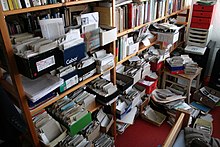Note box
The card box or catalog box (sometimes also out of date card file ) is an aid when creating a literary or scientific work . Matters that appear to be important B. found in a book, are noted on slips of paper or index cards with the source and stored and sorted in boxes.
function
By using a card box or an outline editor , read information is not lost. The note box serves as a reminder. Note boxes are used, for example, in qualitative text analysis ( grounded theory , content analysis ).
The main advantage of a card box over a linear text, for example in the form of a notebook without references, is the possible and very individual networking of the content, which is created through keywording and cross-references.
With the help of electronic media , hyperlinks can be used to create virtual card boxes , for example in the form of a wiki or blog . There is also special software that fulfills the task of a card box, for example Citavi , Lexican or the “ Zettelkasten ” program, which simulates Niklas Luhmann's card box .
Well-known note boxes
The card boxes by Arno Schmidt , Niklas Luhmann , Walter Kempowski , Hans Blumenberg , Friedrich Kittler , Aby Warburg , Paul Otlet , Martin Gardner and Richard Wossidlo are particularly well-known due to their large size and their importance for the work and works of their owners. Even Jules Verne worked with it. The Society of Arno Schmidt Readers (GASL) publishes a yearbook with paper boxes with analyzes of the poet's work.
Exhibitions
The Modern Literature Museum in Marbach showed the exhibition card boxes from March 4 to September 15, 2013 . Machines of the imagination . She tried to depict the secrets, structures and advantages of the card boxes and the work and motives of their creators. Individual card boxes, such as the one by Arno Schmidt for Seascape with Pocahontas and Peter Rühmkorf's card box can be seen in the permanent exhibition of the Literature Museum.
In 2019, the card box from Niklas Luhmann's estate , which has been maintained for decades, was made available as an online version in a university cooperation.
See also
literature
Scientific papers:
- Sönke Ahrens: The card box principle. Successfully write and study academically with effective note-taking. Books on Demand, Norderstedt 2017, ISBN 978-3743124981 .
- Alberto Cevolini, Where Does Niklas Luhmann's Card Index Come From? "Erudition and the Republic of Letters", vol. 3, n.4, 2018, pp. 390-420.
- Heike Gfrereis , Ellen Strittmatter (Ed.): Note boxes. Machines of the imagination. Exhibition catalog. German Schiller Society, Marbach a. N. 2013, ISBN 978-3-937384-85-6 .
- Markus Krajewski : Paperwork. The birth of the card index from the spirit of the library. Kadmos, Berlin 2002 (= Copyrights 4), ISBN 3-931659-29-1 (English: Paper Machines. About cards & catalogs, 1548–1929. MIT Press, Cambridge 2011, ISBN 978-0-262-01589-9 ) .
- Niklas Luhmann : Communication with card boxes. An experience report. In: Niklas Luhmann: University as a milieu. Small fonts. Edited by André Kieserling . Haux, Bielefeld 1992, ISBN 3-925471-13-8 , pp. 53-61 (originally in: Horst Baier et al. (Ed.): Public opinion and social change. For Elisabeth Noelle-Neumann . = Public opinion and social change. Westdeutscher Verlag, Opladen 1981, ISBN 3-531-11533-2 , pp. 222–228.)
- Christoph Schmitt: Note workshop. Field research-based knowledge circulation around 1900 and the practice of paper learning machines using the case study of the "folk researcher" Richard Wossidlo . In: Volkskunde in Sachsen 27 (2015), ISBN 978-3-945363-22-5 , pp. 7–47.
- Helmut Zedelmaier: Note box. In: Memory and Recollection. An interdisciplinary lexicon. Edited by Nicolas Pethes, Jens Ruchatz. Rowohlt Taschenbuch, Reinbek 2001, ISBN 3-499-55636-7 , pp. 671-672.
Artistic preparations:
- Jean Paul (1796): Life of Quintus Fixlein, drawn from fifteen boxes of paper .
- Arno Schmidt (1970): Zettel's dream (novel in 8 books).
Individual evidence
- ↑ Missing Link: Luhmann's thinking machine finally online. Retrieved June 2, 2019 .
Web links
Journalistic articles
- Article My digital study-buddy: the card box diagoge.com, January 27, 2011.
- Article "Everything essential can be found in the card box" Telepolis, April 21, 2013.
- English-language card box homepage. Deals with the card box and the way it is based
Other web links
- "Zettelkasten" according to Niklas Luhmann (open source software)
- Niklas Luhmann's card box as a digitized version
- Zettelkasten 1 of Niklas Luhmann now viewable online info on the website of the University of Bielefeld (14 September 2019. Stand on Nov. 20, 2019).
